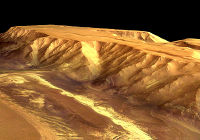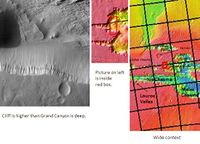Difference between revisions of "Candor Chasma"
m (→Origin of Name) |
|||
| Line 1: | Line 1: | ||
| + | {{Mars atlas}} | ||
[[Image: Valles Marinerislabeled.jpg|thumb|300px|left|Names of features of Valles Marineris canyon syatem]] | [[Image: Valles Marinerislabeled.jpg|thumb|300px|left|Names of features of Valles Marineris canyon syatem]] | ||
[[Image:Cliff in Candor Chasma.jpg|thumb|200px|right|THEMIS, MOLA, HiRISE images of part of Candor Chasma | [[Image:Cliff in Candor Chasma.jpg|thumb|200px|right|THEMIS, MOLA, HiRISE images of part of Candor Chasma | ||
Revision as of 18:47, 8 January 2020
Candor Chasma is one of the largest canyons in the Valles Marineris canyon system. It is located at 6.6 S and 70.9° W (289.1 E) in the Coprates quadrangle. Candor Chasma is 810.61 km long. Mars Reconnaissance Orbiter discovered sulfates, hydrated sulfates, and iron oxides in Candor Chasma.[1] Hence, water has been present in the past to form some of these minerals. Some researchers examined parts of Candor Chasm to find where a future rover might study sediments preserving traces of past life.[2]
Origin of Name
Coprates is the name of a classical albedo features on Mars. The name was approved by the International Astronomical Union (IAU) in 1973.[3]
Chandor Chasma was made famous in the novel "Red Mars" by Kim Stanley Robinson as the location of the first future Mars base after the first manned mission in 2026. The idea of "Underhill", the first established settlement, originates from the Hillside settlement as designed by the Mars Foundation's co-founder, Bruce Mackenzie.

References:
- ↑ Murchie, S. et al. 2009. A synthesis of Martian aqueous mineralogy after 1 Mars year of observations from the Mars Reconnaissance Orbiter. Journal of Geophysical Research: 114.
- ↑ http://themis.asu.edu/feature/36
- ↑ https://planetarynames.wr.usgs.gov/SearchResults?target=MARS&featureType=Chasma, chasmata
External Links
| Concepts: | Greenhouse · Settlements · Locations · General |
| Hazards: | Space Weather · Climate · General |
| Technology: | Hi-Tech · Lo-Tech · Energy · Spaceflight science · Communication · General |
| Human Considerations: | Economics · Health · Governance · Trade · Law · Social |









